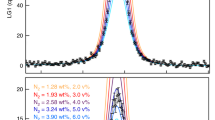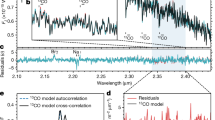Abstract
Pluto's tenuous nitrogen atmosphere was first detected by the imprint left on the light curve of a star that was occulted by the planet in 1985 (ref. 1), and studied more extensively during a second occultation event in 1988 (refs 2–6). These events are, however, quite rare and Pluto's atmosphere remains poorly understood, as in particular the planet has not yet been visited by a spacecraft. Here we report data from the first occultations by Pluto since 1988. We find that, during the intervening 14 years, there seems to have been a doubling of the atmospheric pressure, a probable seasonal effect on Pluto.
This is a preview of subscription content, access via your institution
Access options
Subscribe to this journal
Receive 51 print issues and online access
$199.00 per year
only $3.90 per issue
Buy this article
- Purchase on Springer Link
- Instant access to full article PDF
Prices may be subject to local taxes which are calculated during checkout


Similar content being viewed by others
References
Brosch, N. The 1985 stellar occultation by Pluto. Mon. Not. R. Astron. Soc. 276, 571–578 (1995)
Hubbard, W. B., Hunten, D. M., Dieters, S. W., Hill, K. M. & Watson, R. D. Occultation evidence for an atmosphere on Pluto. Nature 336, 452–454 (1988)
Elliot, J. L. et al. Pluto's atmosphere. Icarus 77, 148–170 (1989)
Elliot, J. L. & Young, L. A. Analysis of stellar occultation data for planetary atmospheres. I. Model fitting, with application to Pluto. Astron. J. 103, 991–1051 (1992)
Millis, R. L. et al. Pluto's radius and atmosphere—Results from the entire 9 June 1998 occultation data set. Icarus 105, 282–297 (1993)
Yelle, R. V. & Elliot, J. L. in Pluto and Charon (eds Stern, S. A. & Tholen, D. J.) 347–390 (Univ. Arizona Press, Tucson, 1997)
McDonald, S. W. & Elliot, J. L. Pluto-Charon stellar occultation candidates: 2000-2009. Astron. J. 119, 1999–2007 (2000)
McDonald, S. W. & Elliot, J. L. Erratum: “Pluto-Charon stellar occultation candidates: 2000-2009”. Astron. J. 120, 1599–1602 (2000)
Elliot, J. L. et al. The recent expansion of Pluto's atmosphere. Nature 424, 165–168 (2003)
Lellouch, E. et al. Pluto's non-isothermal surface. Icarus 147, 220–250 (2000)
Grundy, W. M. & Buie, M. W. Distribution and evolution of CH4, N2 and CO ices on Pluto's surface: 1995 to 1998. Icarus 153, 248–263 (2001)
Yelle, R. V. & Lunine, J. I. Evidence for a molecule heavier than methane in the atmosphere of Pluto. Nature 339, 288–290 (1989)
Strobel, D. F., Zhu, X., Summers, M. E. & Stevens, M. H. On the vertical thermal structure of Pluto's atmosphere. Icarus 120, 266–289 (1996)
Stanberry, J. A., Lunine, J. I., Hubbard, W. B., Yelle, R. V. & Hunten, D. M. Mirages and the nature of Pluto's atmosphere. Icarus 111, 503–513 (1994)
Hansen, C. J. & Paige, D. A. Seasonal nitrogen cycles on Pluto. Icarus 120, 247–265 (1996)
Spencer, J. R., et al. in Pluto and Charon (eds Stern, S. A. & Tholen, D. J.) 435–475 (Univ. Arizona Press, Tucson, 1997)
Sicardy, B. et al. The structure of Titan's atmosphere from the 28 Sgr occultation. Icarus 142, 357–390 (1999)
Null, G. W. & Owen, W. M. Jr Charon/Pluto mass ratio obtained with HST CCD observations in 1991 and 1993. Astron. J. 111, 1368–1381 (1996)
Acknowledgements
We thank the Conseil Scientifique of Paris Observatory and the Programme National de Planétologie for supporting part of the observations of the P126 event in South America. We are grateful to C. Angeli, A. Bruch and D. Lazzaro, who made possible the observational campaign in Brazil, and to W. B. Hubbard for constructive comments.
Author information
Authors and Affiliations
Corresponding author
Ethics declarations
Competing interests
The authors declare that they have no competing financial interests.
Rights and permissions
About this article
Cite this article
Sicardy, B., Widemann, T., Lellouch, E. et al. Large changes in Pluto's atmosphere as revealed by recent stellar occultations. Nature 424, 168–170 (2003). https://doi.org/10.1038/nature01766
Received:
Accepted:
Issue Date:
DOI: https://doi.org/10.1038/nature01766
This article is cited by
-
Nitrogen Atmospheres of the Icy Bodies in the Solar System
Space Science Reviews (2020)
-
The Pluto system after the New Horizons flyby
Nature Astronomy (2017)
-
Planetary science: The Pluto siblings
Nature (2015)
-
Instrumental methods for professional and amateur collaborations in planetary astronomy
Experimental Astronomy (2014)
-
Solar System Capabilities of the Thirty Meter Telescope
Earth, Moon, and Planets (2009)
Comments
By submitting a comment you agree to abide by our Terms and Community Guidelines. If you find something abusive or that does not comply with our terms or guidelines please flag it as inappropriate.



